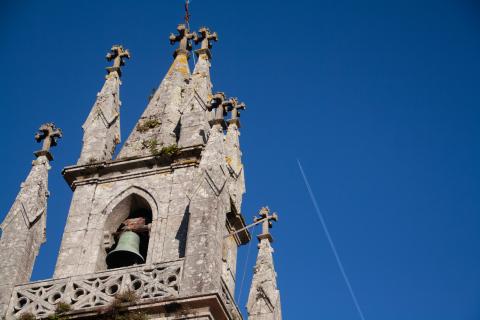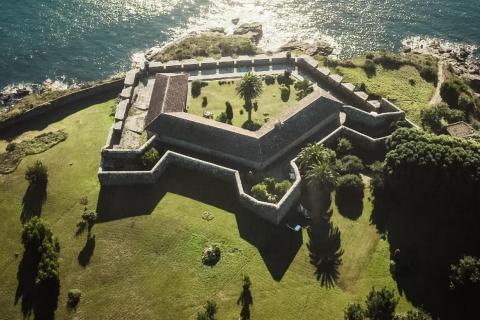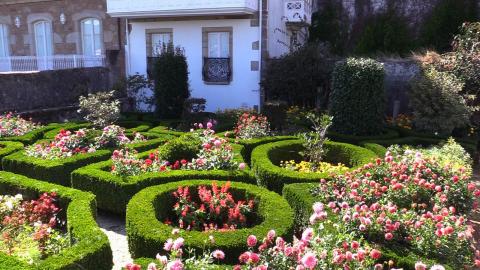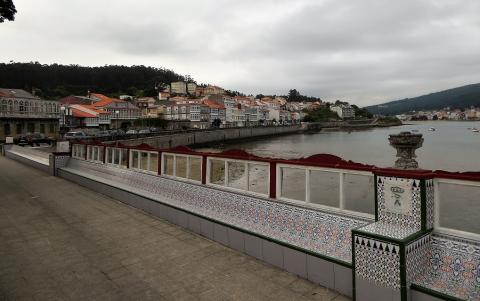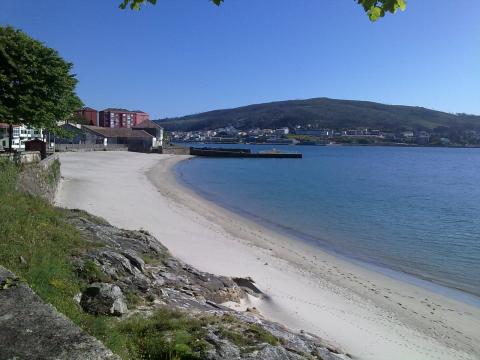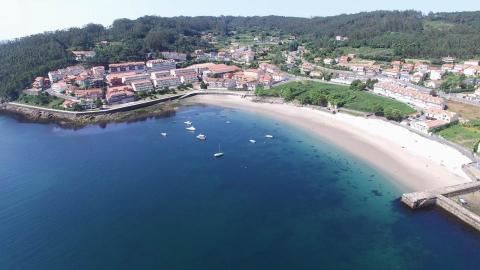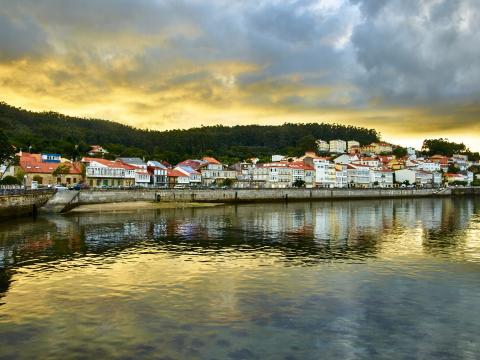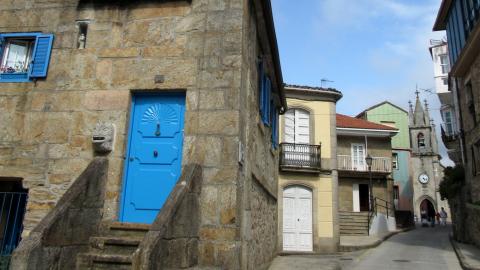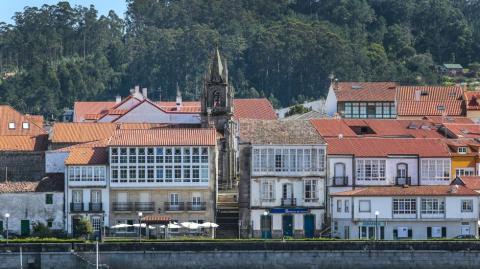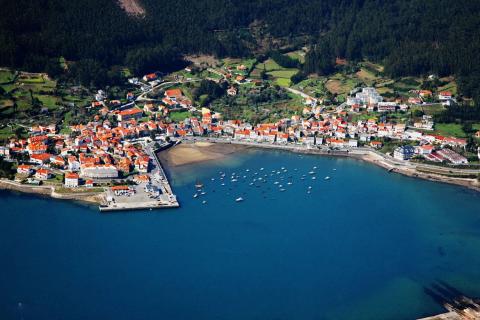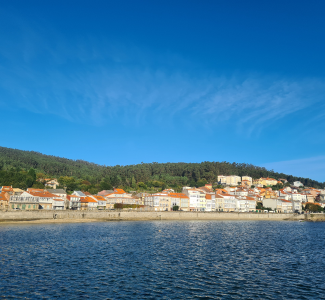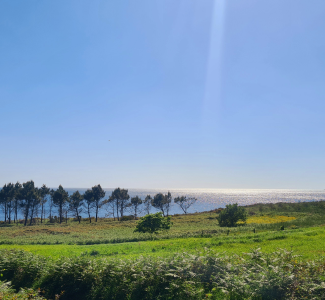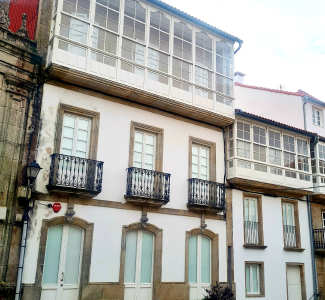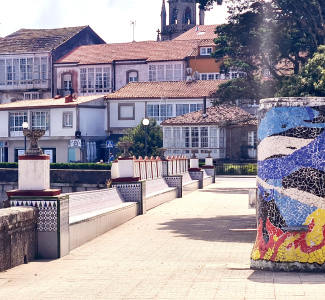
15130 Corcubión (A Coruña)
San Roque’s Municipal Hostel is located in San Pedro’s Recreational Area. Leaving this hostel and walking along the road to the right we reach the AC-445 road. We must cross it very carefully, as there is no pedestrian crossing, to continue straight on through O Vilar. This road is part of the extension of St. James’ Way to Fisterra, but we are going to follow it in the opposite direction. We quickly arrive to the place of O Vilar, where there are also a lot of granaries and several interesting samples of popular architecture.
From there to Corcubión there is a little less than 1 km, which is a permanent descent. If we continue following St James’ Way (in the opposite direction) we have to go on the left and we will have a few pleasant minutes left, as we will advance along the Corcubión’s mountain from where there are beautiful views of the village and its estuary. At the end of this dirt track we reach the town of Corcubión. Continuing on the left we will reach the San Antonio’s Chapel, where we can also see a stone cross. Then, we have to walk down a narrow and steep street (Rúa Perigos – Perigos Street) that goes down towards the south and the centre of the village (by the right side of San Antonio’s Chapel). It is worth the trouble for its uniqueness and for some of the houses in it, such as the Old Fishermen’s Guild Building.
Going down to the end of this street we end up in Rúa Rafael Juan (Rafael Juan Street) and continue to Rúa Antonio Porrúa (Antonio Porrúa Street). Both were part of the old Rúa Real Real Street) which crossed the whole town and where we find good examples of the traditional and emblazoned houses in Corcubión, such as Castreje’s House or the Pazo of the Dios y Pose Family (Dios y Pose Manor), as well as the Pilar’s Chapel.
If we continue to move forward, we return to Praza de Castelao (Castelao Square), where we can see “The Pirate’s House” and the Miñones’ House, another of the unique buildings of this seaside town. Opposite this house we find one of the public fountains that still exist in Corcubión: the four-spout fountain. On the right of the palm grove there are several small streets that lead to the Town Hall building, called José Carrera’s Building. From the Town Hall Square (Praza José Carrera – José Carrera Square), we can see the "back" of Corcubión, which is very rich in curious corners. We recommend the visitor to get lost in this area, always taking Praza de Castelao (Castelao Square) as reference.
We return, again, to Praza de Castelao (Castelao Square). There is still a large part of the town centre to be visited. Looking south, there are three streets starting at the square. The closest one to the sea is Rúa San Marcos (San Marcos Street). Here we find, on the left, the Pazo of the Counts of Altamira, owned and inhabited by the ancient Counts of Corcubión and from which jurisdiction over more than twenty parishes was administered. This jurisdiction was a mixture in between the courthouse and what is now the Town Hall; which had authority over tax collection and soldiers’ levies.
If we go along this street we can admire other relevant houses until we reach Praza Párroco Francisco Sánchez (Párroco Francisco Sánchez Square), where San Marcos’ Church is located. In addition to the church, we can admire one of the most beautiful squares in the village.
We continue along the street that goes up, Rúa das Mercedes (Mercedes Street). In the middle of it, in front of a small square with a stone cross, we can see one of the emblazoned houses that Corcubión has: the Obregón’s House (also known as Teixeira’s House).
Soon we arrive to Campo do Rollo, a quiet place where the playground is located. We recommend again to the visitors to get lost in the streets of this part of Corcubión and discover the singular corners that they can find.
From Campo do Rollo, continuing a little south, is the old Pazo of Antonio de Leira y Castro, an important man who was vice-consul of England in Corcubión, mayor of the village and factor during the war against French troops in 1809.
From here we return to Campo do Rollo and descend in a northerly direction. The first house on the left is the building of the Old Judicial District Court. Sitting in front of the façade of the Old Courthouse (looking towards Praza de Castelao – Castelao Square), we continue to the left until we reach Praza Médico Ramón Carrera (Médico Ramón Carrera Square), where we find the José Sendón’s House, with a sober façade, presided over by a coat of arms, and some other interesting examples of traditional houses. From here, through a small street, we go down again to Praza de Castelao (Castelao Square).
A short distance away is the port of Corcubión, where the building of the Old Judicial District Goal is located. In the port you can see the barges and small boats, creels and other fishing gear used by the town's sailors. Here the building of the Nautical Club and the fish market (only for suppliers) are located.
Once we are in the port, we can either go back to the hostel or walk until Quenxe’s Beach:
- If you want to go back to San Roque’s Municipal Hostel from the port, the easiest way is to go back to Praza de Castelao (Castelao Square) and walk up Rúa Pepe Miñones (Pepe Miñones Street) until we arrive to O Campo do Rollo (where the children’s playground is). From here we only have to follow the yellow shells of St. James’ Way to go back to San Roque’s Municipal Hostel.
- If you decide to go to Quenxe’s Beach (from the port and back is approximately 2km) we have to cross the port and continue walking passing by the remains of A Viña’s Shipyard. To go back to San Roque’s Municipal Hostel from Quenxe’s beach you have two options:
1) You can go back to Praza de Castelao (Castelao Square) and walk up Rúa Pepe Miñones (Pepe Miñones Street) until you arrive to O Campo do Rollo (where the children’s playground is). From here you only have to follow the yellow shells of St. James’ Way to go back to San Roque’s Municipal Hostel.
2) Once you arrive to Quenxe’s Beach, if you walk along the promenade you will have to leave it on the right just before a small children’s playground. Then we walk up Rúa Ramón Caamaño (Ramón Caamaño Street) until we reach the road that leads us to the lighthouse in Cape Cee (Rúa Río Quenxe – Río Quenxe Street) if you walk to the left, and to the village of Corcubión to the right. In this case, you have to walk on the right for a few metres until you reach the AC-445 road at the point where the municipal cemetery is. You cross the road and continue walking on the left. Then, a few metres further on, you will have to turn right up Rúa Doutor Fleming (Doutor Fleming Street). At the next crossroads, you have to turn left up a fairly steep slope (Rúa Camiño do Carro – Camiño do Carro Street) and then you will arrive al O Vilar, where you will pass a fountain and a wash house on the right. Then you walk straight on until you reach the AC-445 road again. You cross the road very carefully and you will arrive to Campo de San Roque, where San Roque’s Municipal Hostel is
1) 1st OPTION (THE LONGEST TOUR)
This route is largely done by asphalt road, although it is not much used by vehicles. It is approximately 10km long.
San Roque’s Municipal Hostel is located in San Pedro’s Recreational Area. Leaving this hostel and walking along the road to the right we reach the AC-445 road. We must cross it very carefully, as there is no pedestrian crossing, to continue straight on through O Vilar. This road is part of the extension of St. James’ Way to Fisterra, but we are going to follow it in the opposite direction. We quickly arrive to the place of O Vilar, where there are also a lot of granaries and several interesting samples of popular architecture.
From there to Corcubión there is a little less than 1 km, which is a permanent descent. If we continue following St James’ Way (in the opposite direction) we have to go on the left and we will have a few pleasant minutes left, as we will advance along the Corcubión’s mountain from where there are beautiful views of the village and its estuary. At the end of this dirt track we reach the town of Corcubión. Continuing on the left we will reach the San Antonio’s Chapel, where we can also see a stone cross. Continuing by the left side, by Rúa Salvador Allende (Salvador Allende Street), we will pass by the Alameda (from where we can contemplate a beautiful view of the town, the port and the estuary presided over by Pindo’s Mount in the background) and walk down Rúa Cruceiro de Baldomar (Cruceiro de Baldomar Street) until we reach AC-445 road.
We continue walking to the right, skirting the sea in the direction to Praza de Castelao (Castelao Square). On the way we will pass by El Hórreo Hotel building (currently closed) and a sculpture of a pilgrim made by the local artist Andrés López, which welcomes all those who come to Corcubión, whether they are pilgrims or not. Some metres after this sculpture, we will pass by Don Ramón Pais’ viewpoint, from where we can contemplate a good panoramic view of the town.
Walking along this stretch of the promenade we can see a series of very relevant bourgeois buildings, until we reach Don Benigno Lago’s viewpoint, characterised by a long bench made of tiles. From here we continue along the promenade towards the port. From there we continue along Plácido Castro Rivas’ promenade to Quenxe’s beach. On this way you will see the remains of A Viña’s shipyard.
If we walk along the promenade’s beach we have to leave it on the right just before a small children’s playground. Then we go up Rúa Ramón Caamaño (Ramón Caamaño Street) until we reach the road that leads to Corcubión’s lighthouse (in Cape Cee) (Rúa Río Quenxe – Río Quenxe Street). At this point we continue walking along this road on the left. After 1.3km we find the Cardenal’s Castle. Continuing along this same road we reach a very large bend on the right, from where a small road branches off to the left and leads us to the municipal football pitch and the Cape Cee lighthouse.
From this cape, there is a beautiful view of the Corcubión estuary. In front of it you can see Pindo’s Mount and in the sea you can see the Lobeira Islands, which guard the entrance of the estuary, as well as the Carromeiro Chico’s Lighthouse and, towards O Pindo, the Carromeiro Grande. Looking to the right you can see the Fisterra peninsula.
We go back and follow the road we left behind. If we continue walking we will arrive at the place of Redonda. At the end of the road that goes down the middle of this place, between the houses, we will find San Pedro de Redonda’s Church, from the 12th century. It is worth going there to see this temple and its atrium presided over by a traditional stone cross,
Redonda is the other parish of Corcubión, together with that of San Marcos. Unlike the latter, the former is fully rural. We can admire a great number of barns and samples of popular architecture in it, besides a beautiful view of the coast of Corcubión and Fisterra.
After going around Redonda we can follow the road in the same direction we took before turning off in Redonda; this way we will find San Roque’s Municipal Hostel on our right.
2) 2nd OPTION (THE SHORTEST TOUR)
This route is largely done by asphalt road, although it is not much used by vehicles. It is approximately 7.5km long.
This tour consists of walking from San Roque’s Municipal Hostel to the lighthouse in Cape Cee, and then come back the same way.
We leave the hostel on the left and walk along the road. Walking straight on we will arrive to Redonda. At the end of the road that goes down the middle of this place, between the houses, we will find San Pedro de Redonda’s Church, from the 12th century. It is worth going there to see this temple and its atrium presided over by a traditional stone cross.
Redonda is the other parish of Corcubión, together with that of San Marcos. Unlike the latter, the former is fully rural. We can admire a great number of barns and samples of popular architecture in it, besides a beautiful view of the coast of Corcubión and Fisterra.
When we reach a tight bend we will see the signpost to the right towards the lighthouse and the football pitch. If we follow it we will reach the Corcubión’s lighthouse, located at Cape Cee.
From the lighthouse, if we want to return to San Roque’s Municipal Hostel, we must retrace our steps.

